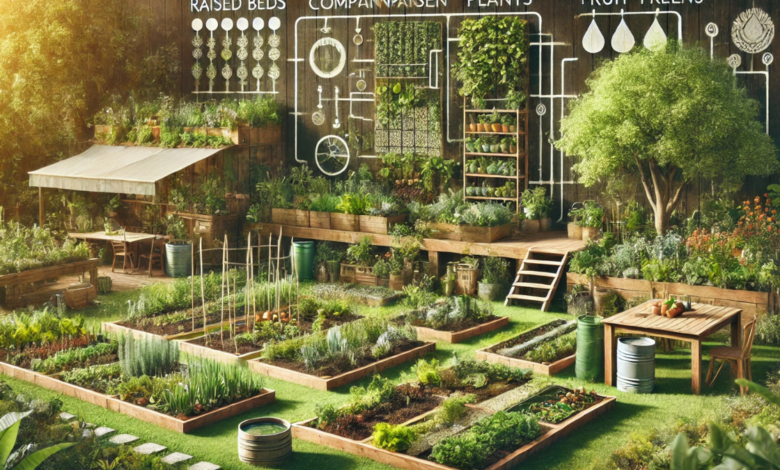The Ultimate Guide to Creating a Thriving Permaculture Garden

Permaculture gardening is not just a method; it’s a philosophy that aligns human activities with nature’s rhythms. By mimicking natural ecosystems, permaculture gardens promote sustainable living, reduce waste, and offer a bounty of fresh produce. Whether you have a sprawling backyard or a small balcony, permaculture can transform your space into an oasis of productivity and harmony. Dive into this guide to discover how to design, build, and maintain a flourishing permaculture garden.
Introduction to Permaculture Gardening
Permaculture, derived from “permanent agriculture,” emphasizes creating ecosystems that are self-sustaining and resilient. Unlike conventional gardening, which often relies on synthetic inputs and monocultures, permaculture is based on principles like working with nature, minimizing waste, and promoting biodiversity.
The beauty of a permaculture garden lies in its adaptability. It’s not about imposing a design but observing and understanding how nature operates. From reducing your carbon footprint to saving on grocery bills, the benefits of permaculture are immense. In today’s world, where environmental challenges are escalating, adopting permaculture gardening is a step toward a sustainable and fulfilling lifestyle.
Designing Your Permaculture Garden

Assessing Your Space
The first step in creating a permaculture garden is understanding your environment. Assess the size, sunlight availability, soil quality, and water resources of your space. Zoning is a key concept here; divide your garden into areas based on their usage and proximity to your home. For example, the home zone may include herbs and vegetables, while the outer zones can host trees and wildlife habitats.
Planning for Sustainability
Sustainability is at the heart of permaculture. Consider planting companion species that benefit each other, such as tomatoes and basil. Layering techniques, like integrating canopy trees, shrubs, and ground cover plants, maximize space while creating a microclimate. Water management is another essential element—swales and rainwater harvesting systems ensure that your garden thrives even during dry spells.
Incorporating Functional Diversity
A diverse garden is a resilient garden. Choose plants that serve multiple purposes—edible crops, medicinal herbs, and pollinator-friendly flowers. Perennials are particularly valuable as they require less maintenance and provide long-term yields. This diversity not only boosts productivity but also attracts beneficial insects and birds, keeping pests in check.
Building the Foundation: Soil Health and Composting
Understanding Soil Types and Testing
Healthy soil is the cornerstone of any successful garden. Start by identifying your soil type—whether sandy, clayey, or loamy—and test its pH and nutrient levels. Knowing your soil’s composition helps you make informed decisions about amendments and planting strategies.
Composting Basics
Composting transforms organic waste into nutrient-rich fertilizer for your garden. Set up a composting system that suits your needs, whether it’s a simple pile, a bin, or vermicomposting with worms. Regularly add kitchen scraps, garden clippings, and dry leaves, maintaining a balance between green (nitrogen-rich) and brown (carbon-rich) materials. Turn the pile frequently to speed up decomposition and prevent odors.
Natural Soil Amendments
Mulching is a simple yet powerful technique to enrich soil and retain moisture. Use organic materials like straw, wood chips, or grass clippings. Cover crops, such as clover or vetch, further enhance soil health by fixing nitrogen and preventing erosion. These practices ensure your garden’s foundation remains fertile and productive.
Planting and Maintaining Your Permaculture Garden
Seasonal Planting Strategies
Permaculture gardens thrive when designed for continuous production. Rotate crops seasonally to maintain soil health and reduce pest buildup. Succession planting, where one crop is sown immediately after another, ensures a year-round harvest. For instance, plant lettuce in early spring, followed by beans in summer.
Integrated Pest Management
Permaculture discourages chemical pesticides, favoring natural solutions instead. Companion planting is a powerful tool—marigolds deter nematodes, while nasturtiums repel aphids. Encourage beneficial insects like ladybugs and lacewings by providing habitats. Homemade pest repellents, such as garlic spray, can also keep your plants safe.
Water Conservation Techniques
Water is a precious resource, and permaculture gardens are designed to use it wisely. Mulching reduces evaporation, while drip irrigation delivers water directly to the roots. Collecting rainwater in barrels or designing greywater systems can further reduce dependency on municipal water.
Continuous Improvement and Observation
A permaculture garden evolves over time. Regularly observe how plants interact and adapt to changes. Use these insights to refine your design, ensuring that it remains productive and sustainable. Embrace experimentation—it’s through trial and error that the most resilient gardens are built.
Expanding Beyond the Garden: Community and Permaculture Ethics
Permaculture extends beyond individual gardens to entire communities. Sharing resources, exchanging seeds, and collaborating on projects strengthen local resilience. The ethics of permaculture—earth care, people care, and fair share—serve as guiding principles. By scaling up your efforts, such as contributing to community food forests, you can make a broader impact on environmental sustainability.
Conclusion
Permaculture gardening is a journey toward harmony with nature. By adopting its principles, you can create a thriving ecosystem that nourishes both the land and your soul. Start small, observe, and let nature guide your efforts. Every step taken toward permaculture is a step toward a greener, more sustainable future.
FAQs
What is the main goal of a permaculture garden?
The main goal is to create a self-sustaining ecosystem that works in harmony with nature, requiring minimal human intervention while maximizing productivity.
Can permaculture gardening be done in small spaces?
Yes, permaculture principles can be applied to any space, from urban balconies to large rural properties.
How long does it take to establish a permaculture garden?
It depends on the size and complexity, but significant results can often be seen within a year, with ongoing improvements over time.
What are some beginner-friendly plants for permaculture gardens?
Perennials like kale, mint, and strawberries, along with nitrogen-fixing plants like beans and clover, are excellent choices for beginners.
How can permaculture gardening help combat climate change?
By promoting biodiversity, reducing waste, and sequestering carbon in the soil, permaculture gardening actively contributes to mitigating climate change.
You May Also Read:https://vlpside.com/
